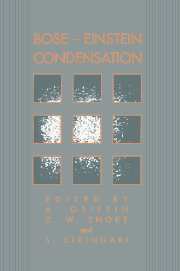Book contents
- Frontmatter
- Contents
- Preface
- Preface to paperback edition
- 1 Introduction: Unifying Themes of Bose–Einstein Condensation
- Part one Review Papers
- 2 Some Comments on Bose–Einstein Condensation
- 3 Bose–Einstein Condensation and Superfluidity
- 4 Bose-Einstein Condensation in Liquid Helium
- 5 Sum Rules and Bose–Einstein Condensation
- 6 Dilute-Degenerate Gases
- 7 Prospects for Bose–Einstein Condensation in Magnetically Trapped Atomic Hydrogen
- 8 Spin-Polarized Hydrogen: Prospects for Bose–Einstein Condensation and Two-Dimensional Superfluidity
- 9 Laser Cooling and Trapping of Neutral Atoms
- 10 Kinetics of Bose–Einstein Condensate Formation in an Interacting Bose Gas
- 11 Condensate Formation in a Bose Gas
- 12 Macroscopic Coherent States of Excitons in Semiconductors
- 13 Bose–Einstein Condensation of a Nearly Ideal Gas: Excitons in Cu2O
- 14 Bose–Einstein Condensation of Excitonic Particles in Semiconductors
- 15 Crossover from BCS Theory to Bose–Einstein Condensation
- 16 Bose–Einstein Condensation of Bipolarons in High-Tc Superconductors
- 17 The Bosonization Method in Nuclear Physics
- 18 Kaon Condensation in Dense Matter
- 19 Broken Gauge Symmetry in a Bose Condensate
- Part two Brief Reports
- Appendix. BEC 93 Participant List
- Index
17 - The Bosonization Method in Nuclear Physics
Published online by Cambridge University Press: 15 December 2009
- Frontmatter
- Contents
- Preface
- Preface to paperback edition
- 1 Introduction: Unifying Themes of Bose–Einstein Condensation
- Part one Review Papers
- 2 Some Comments on Bose–Einstein Condensation
- 3 Bose–Einstein Condensation and Superfluidity
- 4 Bose-Einstein Condensation in Liquid Helium
- 5 Sum Rules and Bose–Einstein Condensation
- 6 Dilute-Degenerate Gases
- 7 Prospects for Bose–Einstein Condensation in Magnetically Trapped Atomic Hydrogen
- 8 Spin-Polarized Hydrogen: Prospects for Bose–Einstein Condensation and Two-Dimensional Superfluidity
- 9 Laser Cooling and Trapping of Neutral Atoms
- 10 Kinetics of Bose–Einstein Condensate Formation in an Interacting Bose Gas
- 11 Condensate Formation in a Bose Gas
- 12 Macroscopic Coherent States of Excitons in Semiconductors
- 13 Bose–Einstein Condensation of a Nearly Ideal Gas: Excitons in Cu2O
- 14 Bose–Einstein Condensation of Excitonic Particles in Semiconductors
- 15 Crossover from BCS Theory to Bose–Einstein Condensation
- 16 Bose–Einstein Condensation of Bipolarons in High-Tc Superconductors
- 17 The Bosonization Method in Nuclear Physics
- 18 Kaon Condensation in Dense Matter
- 19 Broken Gauge Symmetry in a Bose Condensate
- Part two Brief Reports
- Appendix. BEC 93 Participant List
- Index
Summary
Abstract
The bosonization method developed in nuclear physics in the last 20 years is briefly reviewed.
Introduction
In the last 20 years, a considerable amount of work has gone into the development of bosonization methods for highly correlated finite fermion systems. This work has been stimulated by the phenomenological successes of the interacting boson model introduced in 1974 in which atomic nuclei composed of nucleons (fermions) are treated in terms of an interacting system of bosons (fermion pairs). In this article the logic scheme of the bosonization method in nuclear physics will be briefly reviewed. The purpose here is to provide the basic references upon which the review is built and sources where further references can be found. Bosonization methods were introduced much earlier than 1974 in connection with infinite Fermi systems. The method developed in nuclear physics has some similarities with those developed in other areas of physics, but it also has major differences. In nuclear physics one maps not only operators but also states and seeks a description not only of the ground state but also of the entire excitation spectrum. Furthermore, number projection plays a very important role contrary to the case of infinite systems where number projection is not relevant. These differences, and others, will be briefly remarked upon in this article.
Strongly Interacting Finite Fermion Systems
Fermions and the Shell Model
Quite often in physics one has to deal with a system of interacting fermions.
- Type
- Chapter
- Information
- Bose-Einstein Condensation , pp. 418 - 437Publisher: Cambridge University PressPrint publication year: 1995



